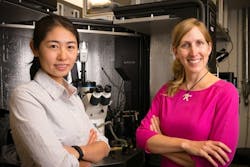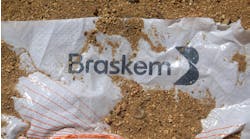Filter Makes Light Work of Chiral Separations
An optical filter to sort lab-made chiral molecules could lead to purer and safer drugs and agrichemicals, believe researchers at Stanford University, Stanford, Calif. In addition, the method being developed could serve other uses, such as monitoring the folding or unfolding of a protein or enabling light-mediated synthesis of chiral chemicals, they say.
Figure 1. Jennifer Dionne (right) and Yang Zhao are developing a new technique that uses light to separate mirrored molecules. Source: Aaron Kehoe, Stanford News Service.
“Approximately 50% of drugs and 30% of agrichemicals are chiral, which means they can be left- or right-handed. Of those, more than 90% are sold as mixtures of both-handed molecules because it’s so hard to separate them,” explains Jennifer Dionne, associate professor of materials science and engineering, who led the research. Such enantiomers can be hard to tell apart and can have vastly different effects. Separating them can be expensive, time-intensive and inefficient.
To resolve this issue, the researchers use highly focused beams of light, called optical tweezers, to manipulate particles. However, many chiral forms of molecules are too small to be pulled apart by optical forces directly.
[callToAction ]
So, to address this, Yang Zhao, a postdoctoral fellow at Stanford, created a nanostructure that allows circularly polarized light to interact more strongly with small specimens. The nanostructure filter, when illuminated with a laser, attracts one side of the chiral molecules while repelling its mirror image.
“Our goal is to use chiral light to create enantio-pure pharmaceuticals and agrochemicals. Hopefully, this approach reduces the cost and time involved with current industry standards for separating chiral mixtures. We hope that this optical separation scheme helps to minimize the unwanted side effects and environmental toxicity of pharmaceuticals, herbicides and pesticides,” notes Zhao.
To test their prototype, the researchers measured the forces exerted on chiral specimens using a chiral optical force microscope, which combines the optical tweezers with an atomic force microscope (AFM), a tool capable of resolving the chemical structure of a single molecule. A chiral AFM tip served as the chiral specimen while simultaneously mapping out the forces specific to the handedness of the tip. Results showed their tweezers produced optical forces strong enough to separate certain chiral molecules. More details appear in a recent issue of Nature Nanotechnology.
The team hasn’t yet tested the tweezers on actual chiral specimens, but Zhao is currently validating the scheme using DNA and other chiral macromolecules. “We are also designing optical filters that will work on small molecules (work recently funded by the Moore Inventors Fellowship) and hope to have a working prototype in three years,” she adds.
Other challenges still need addressing in developing this approach. “Foremost, we need to increase the efficiency of separation for large analyte quantities. Right now, the technique only works if the molecules are very close to our coaxial substrate. We also need to develop schemes that work with small molecules, rather than chiral macromolecules or nanoparticles. We are working on both challenges now, combining updated substrate designs with an improved experimental platform.”
Several pharmaceutical companies have expressed interest in testing the technique, says Zhao. In addition, she believes the method could not only be used to separate chiral mixtures but also to accurately measure the structure of chiral molecules. “We would be delighted to collaborate with chemical engineers to apply our technology to industry challenges,” she adds.



